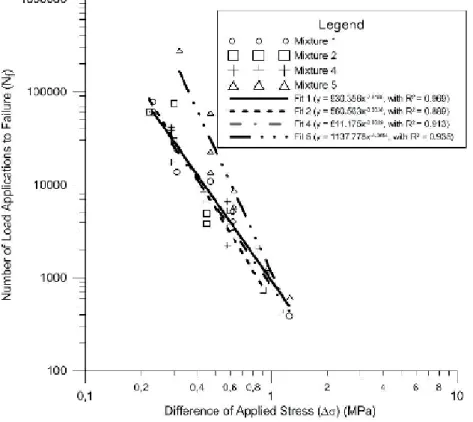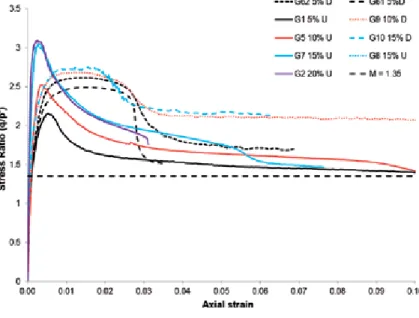Over the past decade, there has been a significant increase in the use of recycled materials in the construction industry. However, finding innovative uses for recycled materials is one of the current priorities in the construction industry.
Introduction
Research on the reuse of foundry sand waste in the construction industry is very important as it is the largest consumer of virgin sand. In the following paragraphs, foundry sand used and its properties are discussed in detail.
Used foundry sand
Dogan-Saglamtimur [3], from the research on the reuse of foundry sand waste in the production of geopolymer concrete, described that foundry sands have a loose structure in nature. Since the amount of used foundry sand is so large, the disposal of used foundry sand in landfills is significantly affecting the ecology and environment.
Properties of used foundry sand
Physical properties
The specific gravity of the casting sand used depends on the properties of the virgin sand and the type of binders used. Most of the researchers did not report the fineness modulus and moisture content of the used foundry sand.
Chemical properties
The surface moisture content of the sand can reduce the water demand of the concrete and mortar mix. A comparative chart of gradation of natural sand and used foundry sand as reported by Prabhu et al.
Mechanical properties
Applications of used foundry sand in the construction industry The used foundry sand can be used in partially or fully for all the purposes
- Road materials
- Cement concrete
- Geopolymer concrete
- Cement mortars
- Precast concrete products
The use of used foundry sand can significantly reduce the cost of mortar. The inclusion of used foundry sand has shown a mixed response on the compressive strength of paving blocks.
Properties of fresh concrete made with used foundry sand
- Workability
- Temperature
- Density
- Air content
Due to the inclusion of used foundry sand in the concrete mix, the temperature of the fresh concrete mix changes. In the research report on the application of foundry sand used in concrete production, Prabhu et al.
Properties of hardened concrete made with used foundry sand
- Compressive strength
- Split tensile strength
- Flexural strength
- Modulus of elasticity
Many researchers have reported the hardened properties of concrete made with used foundry sand during different curing periods. In some cases, the compressive strength of concrete made with partial replacement of fine aggregates with used foundry sand was below or equal to that of the control mix.
Absorption and permeability characteristics of concrete made with used foundry sand
- Water absorption
- Rapid chloride permeability
- Sorptivity
- Carbonation
The concrete made with used casting sand is generally more permeable than the normal concrete. In some cases, the used casting sand content in the concrete increases the chloride permeability.
Ultrasonic pulse velocity (UPV) tests on used foundry sand concrete The ultrasonic pulse velocity (UPV) test is one of the nondestructive tests
Long-term strength characteristics of concrete made with used foundry sand
Leaching in concrete and mortars made with used foundry sand The used foundry sand is a nonhazardous material. However, the chemicals
Conclusion
Most researchers are of the opinion that the foundry sand used is a non-hazardous material. Experimental research on high-quality concrete with used casting sand as a partial replacement of fine aggregates.
Used materials 1 Cement
Sand
Hebhoub and Belachia [1] studied the valorisation of marble waste aggregates in the concrete composition with total and partial incorporation from 0 to 100%, they found an improvement of the compressive and tensile strength as well as the workability of the concrete. 9] studied the addition of marble dust in cement production and obtained very similar results to those observed in our study.
Water
5] reused marble waste as sand in self-compacting concrete, they found that replacing marble waste reduced density and air content, and ensured cohesion and resistance to segregation. The third sand is a marble waste sand from the Filfila quarry—Skikda class 0/2 (discarded powder exposed to the weather).
Experimental program
Marble waste sand is rich in calcium carbonate, while the essential component of natural sand is silica. The different mixtures are made by replacing four percentages of natural sand with the same mass percentages of marble waste sand.
Tests performed
Samples produced from fresh mortar were demoulded after 24 hours and then cured in water at 202°C until the date of the test.
Results and discussion 1 Consistency of mortars
- Density of mortars
- Air content
- Compressive and flexural tensile strength of mortars
- Absorption by immersion
- Weight loss
- Shrinkage
- Acid attack
The increase in mortar density at 15% marble waste sand is about 1.52%. The introduction of waste marble sand (Figure 9) leads to a decrease in air content regardless of the degree of replacement.
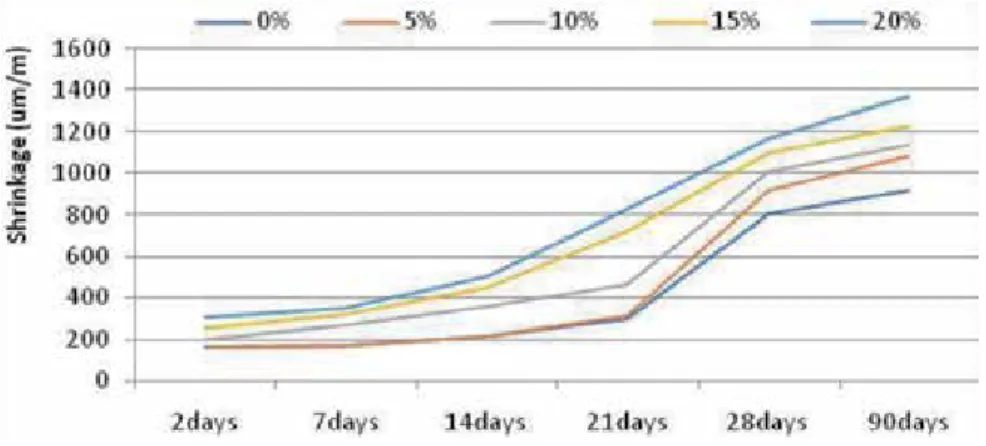
Conclusions
The best consistency is achieved by the mortars based on 15% marble waste sand, the presence of fine particles promotes the immersion of the mortars. The absorption of water from mortars containing marble waste sand is high compared to that of the control mortar.
Literature review
In terms of physical properties, the density of the mixture decreased as the percentage of WFS in the asphalt concrete increased. The indirect tensile strength of asphalt-cement mixtures decreased as the percentage of WFS material increased.
Materials and methods 1 Origin of materials
- Characterisation of materials
- Dosage method of the SMA mixtures
- Production of SMA samples in the laboratory
- Physical and mechanical properties of SMA mixtures
After the tests, the Marshall parameters of the mixtures were determined: bulk specific gravity (BSG), theoretical maximum specific gravity (TMG), air void volume (AVV), voids in the mineral aggregate (VMA), voids filled with asphalt. After the tests, the Marshall parameters of the mixtures were determined: bulk specific gravity (BSG), theoretical maximum specific gravity (TMG), air void volume (AVV), voids in the mineral aggregate (VMA), voids filled with asphalt.
Results and discussion 1 Characterisation of materials
Physical characteristics of mixtures
This reason is probably due to the absorption characteristics of this residue, and not to the grain size [10, 32], since CP has a larger particle size and thus a smaller surface area and thus should consume less AC, at the same amount of WFS. The other mixtures maintained a slight decrease in this parameter when the proportion of WFS in the mixture was increased [7, 9, 13].
Mechanical characteristics of mixtures
On the other hand, the conventional mixture 1 represented the highest value of this ratio, indicating a more rigid behavior. In terms of permanent deformation, mixes 2 and 3 have lower values than mix 1, and mix 5 has the highest value among the others.
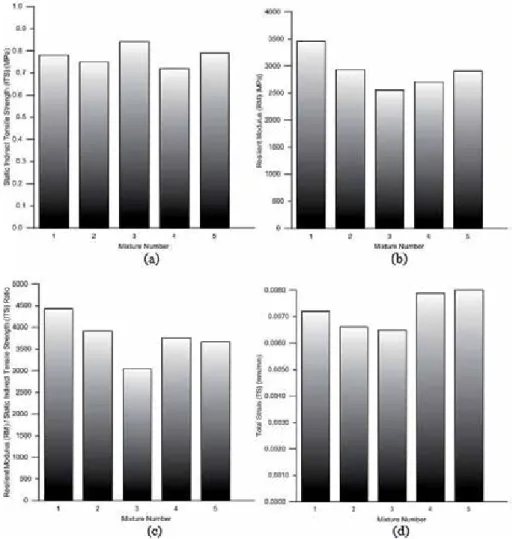
Conclusions
The average RM and static ITS of each mixture were used to obtain the fatigue curves. It should be emphasized that mixture 5 showed the second best ITS result and the second closest value of the RM/ITS ratio around 3000, which justifies the use of this parameter as a quantitative indicator of the fatigue resistance of asphalt mixtures.
Sourcing and aggregate production for Ethiopian construction industry
Sources of aggregate in Ethiopian past, present, and future trends The natural aggregates are formed as a result of the processes of weathering
Production of fine aggregate type, quality, production, and quarrying trend and method
Production of coarse aggregate type, quality, production, and quarrying trend and method
Environmental impact of aggregate production
- Impact on landscape and land stability
- Impact on the atmosphere
- Impact on water resource
- Impacts on biodiversity
- Social impacts of quarry
In the future, however, environmentalists are likely to take on much of the standardization work. Excavation, excavation, damping of overburden soil, drilling and rock blasting are the serious causes of soil erosion due to quarry sites.
Legal framework
In 2013, he reported that there was a working coarse aggregate quarry 60 m from a cooperative housing estate in the capital city of Ethiopia; this affects both structures and nearby residents (Figure 6).
Conclusion
Fine aggregate production and its environmental impact in some selected areas of the Rift valley area of Ethiopia. All the experimental results show that the properties can meet the requirements of the Chinese National Code.
Technical requirements of normal-weight sand
This study mainly discusses artificial sand, and all subsequent experiments were conducted strictly according to Chinese national standards.
Technical requirements of lightweight aggregate
The MS is made of several mother stones, the strength of which should be in accordance with Table 1 [3]. The sand ratio (sand-to-sand and coarse aggregate weight ratio, Sp, %) should be well improved when selecting Zone I sand to maintain a sufficient cement content to meet the workability requirement of concrete.
Lightweight aggregate concrete
- Autogenous shrinkage properties of LWACs
- Durability properties of LWACs
- Softening properties of LWACs
- Properties of LWACs after elevated temperature treatment The appearance characteristics and strength of LWACs are shown in
- Properties of LWACs cured at negative temperature
- Uniaxial stress-strain curves of LWACs
- Multiaxial strength of LWACs
The internal structure of ALWC becomes non-uniform, and thus the strength of ALWC depends on the strength of the mortar. On the other hand, the strength of GLWC is slightly higher than that of ALWC under the same conditions.
Properties of lightweight sand foamed concrete
Properties of reinforced ALWC
Burst load and maximum crack width Pcr(kN) ωcr, max(mm) Pk(kN) ωk, max(mm) Pu(kN) ωu,max(mm). Burst load and maximum crack width Pcr(kN) ωcr, max(mm) Pk(kN) ωk, max(mm) Pu(kN) ωu,max(mm).
Properties of lightweight sand mortar 1 General performance of mortar
Durability of mortar
Fire-resistant performance of mortar
Due to the porosity of SP, the apparent density and coefficient of thermal conductivity in the dry state are lower than those of ordinary sand mortar, so SP has better thermal insulation. Below 300 °C, the strength and coefficient of thermal conductivity increase; however, at temperatures above 300°C, the strength and thermal conductivity coefficient decrease, and all parameters increase with increasing strength level.
Summary
On the other hand, the axial compressive strength of ALWC is close to the cubic compressive strength, which indicates that ALWC has a self-lubricated antifriction effect due to SC. The injection process leads to heterogeneity in calcite distribution and consequently to variability in the mechanical response and permeability of the bio-cemented soil.
Materials and methods
The effects of confining stress of soil on the geomechanical behavior of bio-cemented specimens. Once the UCS and triaxial shear tests were completed, bio-cemented samples were extracted and analyzed to determine the amount and distribution of the calcite precipitated.
Unconfined compressive strength tests
Nevertheless, the consistent trend with calcite content suggests that the results reasonably represent the performance of biocemented sand. In contrast, the low calcite bio-cemented samples prepared by mixing in this study all showed significant improvements in resistance.
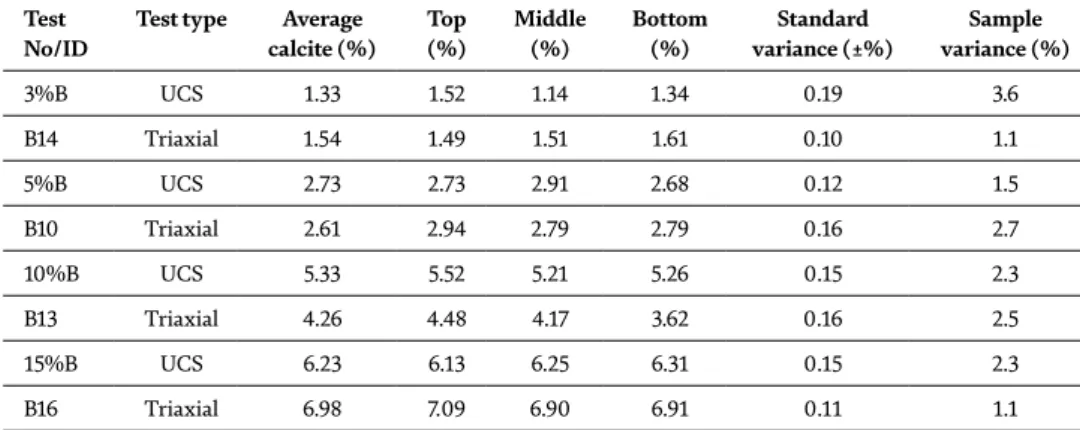
Curing process and bender elements
The progress of the cementation process during hardening was monitored using bending elements by recording the rate change of the shear wave over time. The shear wave velocity variations during the calcite precipitation and hardening of the biocemented samples are shown in Figure 6.
Triaxial stress: strain responses 1 Uncemented sand
Gypsum-cemented sand results
Variation of Gmax with p' for uncemented sand (a) dry and saturated Sydney sand (b) validation with published data. The flexural element technique was used to obtain the shear wave velocity (Vs) for the uncemented sand.
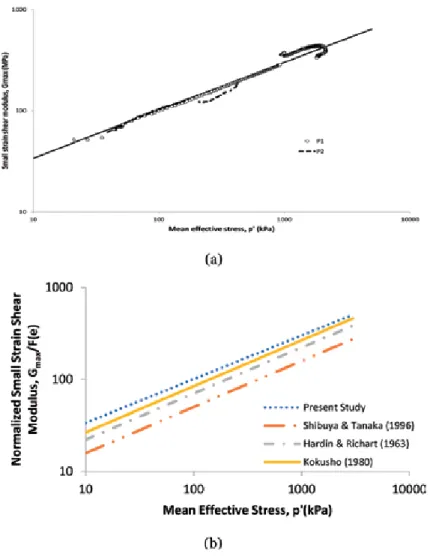
Bio-cemented sand specimens
The variability of the amount of calcite obtained from UCS and triaxial tests can be motivated by several reasons. Previous research [17] claims that the strength of UCS in bio-cemented sample is affected by the level of saturation.
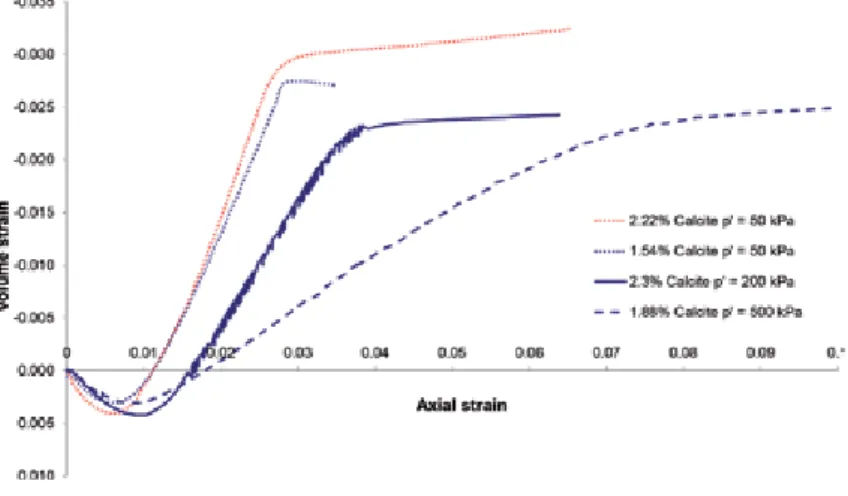
Conclusion
This research was conducted in the best interest of the corresponding author's PhD research work. Unconfined compressive strength and visualization of the microstructure of coarse sand subjected to different biocementation levels.


